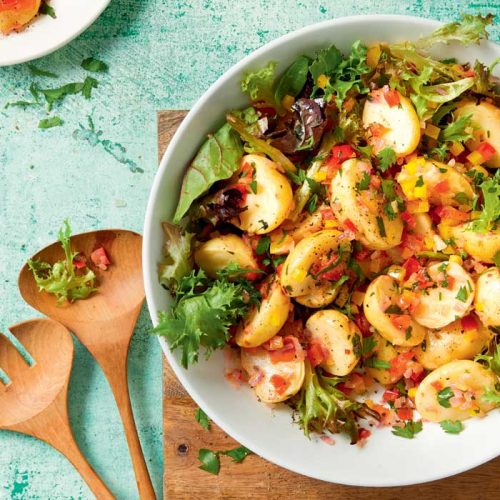
Georgia Rickard asked readers to share the weight-loss challenges they find the most difficult – then asked the experts to devise fool-proof solutions.
“I feel I need the ‘kick-start’ of a detox – but it’s hard to maintain”
It’s common when the end of January rolls around that we start to feel the weight (literally) of the indulgence of the summer holiday season. It can seem like a good idea to go on a ‘detox’ diet where you eliminate ‘bad’ foods and exist on fruit, vegetables and water (or less, in the case of the Lemon Detox diet, which consists of lemon juice, maple syrup and cayenne pepper).
While this can make us feel like we’re ‘being good’ psychologically, it’s not the way to sustained, long-term weight-loss. Rose Carr, Healthy Food Guide’s senior nutritionist, says: “The concept of going on a detox to eliminate a build-up of ‘junk’ in the system is flawed, and is in fact unnecessary. There’s nothing wrong with wanting to eat healthier after a period of over-indulgence. But the body has really good systems – like our liver and kidneys – to eliminate toxins without the need to do anything drastic like fasting or eliminating whole food groups. There is no scientific evidence that a detox diet helps rid the body of toxins any faster.”
-
To beat it: Instead of a ‘de-tox’, why not think of it as a ‘re-health’, and instead of eliminating bad foods, start adding good things to your diet instead, eg. pick one or two of these small steps and include them in your daily routine:
– make half your plate vegetables
– add a serving of dairy
– make ‘seconds’ salad or vegetables
– snack on fruit or low-fat yoghurt
– eat foods from as many different colours as you can each day
– always start the day with a good breakfast
– have small treat foods and really savour them
– add a 10 to 15-minute walk to your lunch break
– choose more wholegrain carbohydrates
“I have a ‘second stomach’ for dessert”
Have you ever eaten a giant plate of food – but still had room for dessert? You’re not the only one, says Dr Gie Liem, social and behavioural nutrition lecturer at Deakin University, Melbourne. “Humans can’t survive on one food – our brains are programmed to seek out variety,” he says. So when you’ve finished dinner, but something sweet still sounds good, “you’re experiencing what’s known as ‘sensory specific satiety’.”
Dr Liem says this is a function we needed as hunters and gatherers to ensure we got the most nutrients possible out of our food, “but the huge variety of foods at our fingertips these days can encourage us to keep eating even when our stomach has had enough.”
Sensory specific satiety isn’t just about taste, either, he says. “Studies have shown that people eat more of their sandwich when it has more than one filling in it; that people will eat more pasta when you’ve got different pasta shapes instead of just the one shape. Textures, colours, anything that gives you a ‘selection’, makes a difference to how long it takes to feel satisfied.”
Still, Dr Liem says you can use sensory specific satiety to your advantage. “This is also the reason why the first few bites of chocolate taste amazing, but after that, they stop tasting as good. It can also work to stop you from overeating.” If you want to eat less, he says, “use very intense flavours, as these will satisfy you faster, and don’t use a lot of different flavours in the one dish.”
Dr Liem says an ideal meal would be a rich, spicy curry followed by a couple of squares of intensely rich, dark chocolate. “And don’t forget to add a rainbow of different-coloured vegetables to your plate,” he adds. “It’s the one instance sensory specific satiety can be used to get you eating more!”
- To beat it: Choose foods with a tougher texture, says Dr Liem. “Studies of liquids versus semi-solid and solid foods have shown that the chewier the texture, the less we consume. You get greater satisfaction out of chewing than drinking, and a sense of satiety sooner.”
“I can’t stop at just one”
Why is it that some of us can eat one brownie, but the rest of us eat one, then another, and maybe a packet of chips and a bowl of ice cream to go with it – ‘blowing off’ the whole day of healthy eating? If this sounds like you, you may be part of a group researchers call ‘restrained eaters’. Restrained eaters restrain their eating habits in accordance with ‘rules’ they’ve made about what they can and can’t eat – only to ‘break’ their rules and end up overeating.
Recent research suggests that this kind of counter-intuitive eating almost always involves low self-esteem, and a belief that certain foods are forbidden. These people are also usually in the habit of coping with negative emotions by eating, so when they ‘break’ their diet and feel upset with themselves, they often end up eating more to feel better about it.
- To beat it: To overcome your ‘rules’ but still eat healthily, research suggests the first step is to practise reminding yourself that it’s OK to eat whatever you like – in moderation.
“I eat well (or not much) during the day – it’s after 4pm that’s the problem”
We tend to reach for less healthy foods later in the day. Clinical psychologist Dr Julie Malone says, “The majority of people we see report the most difficult time in relation to food is in the late afternoon and after dinner.”
A number of possible factors contribute to this,” she says. “Late in the afternoon, energy levels tend to drop off. If you haven’t been eating healthily and consistently throughout the day, you increase your chances of having a ‘low’.”
To combat this, Dr Malone suggests eating a diet with sufficient energy to get through the day, having breakfast, and eating every two to three hours.
If you are eating well, food might not be the only issue, says Dr Shantha Rajaratnam, a lecturer in medicine at Harvard University who specialises in chronobiology (the science of our internal body clock). “Our bodies have evolved to rely on natural light and darkness for cues on when to produce both sleep and energy-inducing hormones,” he says.
Natural light has the effect of enhancing our alertness. And research has shown that even if you deprive people of sleep slightly, you can actually improve their alertness and cognitive performance by putting them in a brightly lit environment.” So if you’re inside all day, he explains, your body won’t receive the same cues to produce ‘energy’ hormones.
- To beat it: Next time you’re feeling drowsy, try stepping outside for a few minutes rather than opening the fridge. Even if it’s not sunny outside, you will find the exercise a good pick-me-up. Dr Malone says, “There is also a difference between eating because you are hungry and eating due to emotional reasons such as boredom, sadness and stress.” If you’ve finished dinner but find yourself reaching for more, “you might find it helpful to learn how to be mindful about why you are craving food,” she advises.
“I eat healthily – until I’m out with friends”
We’ve all been to a social gathering and eaten more than we intended. Research shows we eat nearly twice as much when we eat with a large group of friends. “There is very little we do in social groups that does not involve food,” says Professor Ian Caterson, director of the Institute of Obesity, Nutrition and Exercise at the University of Sydney. And it is often men who are most susceptible. “Of my female patients, 70 per cent are emotional eaters who know exactly what and how much they should eat, but every once in a while they ignore that. Mostly, it’s men who don’t realise what and how much they’re eating – they’re much more influenced by social circumstances,” he says.
Regardless of gender, having an overweight social circle increases your likelihood of being overweight. A study conducted over 32 years by Harvard Medical School found that obesity risk increases by 57 per cent if you have overweight friends, 40 per cent with overweight siblings and 37 per cent with an overweight spouse. It’s likely, researchers say, that we unconsciously adopt the eating habits of those around us. Combined with a tendency to eat more in social settings, this makes portion control difficult.
- To beat it: To lessen your risk of overeating without having to sacrifice social activities, it’s all about habit. “Stop and think twice before you put another bite in your mouth,” says Professor Caterson. “Ask, ‘what are my limits? Am I hungry? If I’m not hungry, why am I still eating?’” It sounds simple, he says, “but most of us don’t do it.”
www.healthyfood.com










